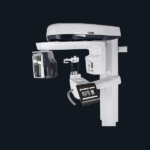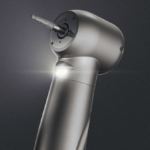
Injecting patients with syringes is a common practice in a medical and healthcare setting and one of these is an intramuscular injection.
With the help of intramuscular injection, a doctor can deliver medication into the muscle.
Moreover, they frequently use this injection to administer vaccines and certain other drugs.
People with certain conditions like multiple sclerosis and rheumatoid arthritis may need to give themselves this type of injection at home.
However, they can also seek help from a caregiver to administer the injections.
It is important to note that the intramuscular route allows rapid absorption of drugs into the circulation of the patients.
Furthermore, using the correct injection and selecting the right site will help to minimize the risk of complications.
Keep on reading to learn more about intramuscular injection in detail.
Uses of Intramuscular Injection
In modern medicine, the use of intramuscular injection is a common practice.
Doctors use them to deliver drugs and vaccines.
Moreover, a number of drugs and almost all injectable vaccines are delivered this way.
In a medical setting, doctors use intramuscular injections when other types of delivery methods are not recommended.
These include:
- oral, i.e. patients swallow into the stomach
- intravenous, i.e. doctors inject these into the vein
- subcutaneous, i.e. doctors inject these into the fatty tissue under the layer of the skin.

It is important to note that intramuscular injections can be used instead of subcutaneous injections.
This is because some drugs can irritate the veins or because a suitable vein cannot be located.
While doctors can also use them instead of oral delivery because the digestive system can destroy them when patients swallow them.
Another important thing to note is that intramuscular injections absorb faster than subcutaneous injections.
This is because muscle tissue has a greater blood supply than the tissue under the skin of the patient.
Muscle tissue can also hold a larger volume of medication than subcutaneous tissue.
Learn more about Ultrasonic Cleaner: How Does it Work? here.
Types of Injections
There are different types of injections and their use depends on the purpose of medication or substance in the shot.
Let’s discuss them as follows:
Intravenous Injections
A healthcare professional will use intravenous, IV injections to give medications directly into the vein.
When the doctor injects it directly into the bloodstream, it allows for rapid absorption, according to research.
Moreover, this causes an immediate response.
A medical professional can administer IV medications as a single dose or as an infusion over a period of many hours.
Doctors can use it to:
- administer fluid solutions and electrolytes
- give local and general anesthesia
- administer pain medications
- give blood or blood products
- provide nutrition, iron, contrast dye, steroids, chemotherapy
- infuse monoclonal antibodies
Intramuscualr Injections
Doctors use intramuscular infections to deliver medication into the muscle tissue of the patients.
The muscles have a rich blood supply, which helps the body to absorb medication quickly.
Subcutaneous Injections
Healthcare professionals administer subcutaneous injections into the fatty tissue just below the skin and above the muscle tissues.
Moreover, they will use a smaller needle to give a subcutaneous injection to make sure that the medication enters the fatty tissue and not the muscle.
It is important to note that these injections are less painful and less likely to have an adverse reaction.
Common uses are the administration of insulin, heparin, measles and chickenpox vaccine, and other home-administered drugs.
Intraosseous Injections
These injections use a special needle to puncture the bone marrow in order to reach the veins, while the bone marrow has a rich supply that connects straight to the circulatory system.
Many healthcare professionals and doctors reserve intraosseous injections for emergencies.
Furthermore, it is the quickest way to give fluids, drugs, and blood products to patients in different emergency situations.
These may include severe injuries, electrocution, a medication overdose, childbirth complications, respiratory disease, prolonged or back-to-back seizures, accidental poisoning, insulin shock, stroke, etc.
Let’s discuss intramuscular injection sites:
Deltoid Muscles of the Arm for Intramuscular Injection
The deltoid muscle is the site doctors most typically use for vaccines.
However, this site is not common for self-injection as its small muscle mass limits the volume of medications that doctors can inject.
This volume consists of no more than 1 millimeter.
Thus, it is a difficult site to use for self-injection.
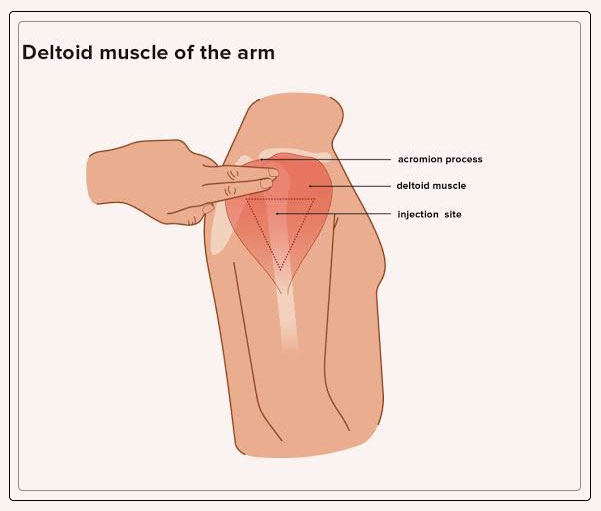
A caregiver, friend, or family member can assist with injections into this muscle.
To locate this site, feel for the bone or acromion process that is present at the top of the upper arm of the patient.
The correct area to give this injection is two finger widths below the acromion process, while at the bottom of the two fingers will be an upside-down triangle.
Give the injection in the center of the triangle.
Learn more about Medical Items: Guide here.
Vastus Lateralis Muscle of the Thigh and Ventrogluteal Muscle of the Hip
Doctors can use the thigh when other sites are not available or the patients need to administer the medication on their own.
For this, divide the upper thigh into three equal parts and locate the middle of these three sections.
Then, the injection should go into the outer top portion of this section.
On the other hand, the ventrogluteal muscle is the safest site for both adults and children older than 7 months of age.
It is deep and not close to any major blood vessels or nerves.
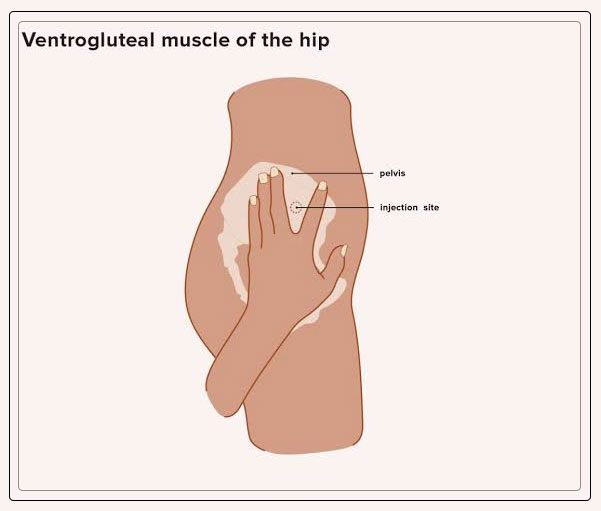
Moreover, it is important to note that this site is difficult for self-injection.
Therefore, patients will need the help of a friend, family member, or caregiver for its administration.
Place the heel of the hand on the hip of the person receiving the injection, with the fingers pointed toward the head.
Position the fingers so that the thumb points toward the growing and you can feel the pelvis under the pinky finger.
Spread your index and middle fingers in a slight V shape and inject the needle into the middle of the V and then remove the needle.
Dorsogluteal Muscles of the Buttocks for Intramuscular Injection
The dorsogluteal muscle of the buttocks was the most common site healthcare professionals used to select for a number of years.
However. due to the potential for injury to the sciatic nerve, the ventrogluteal muscle is used instead.
Moreover, this site in the dorsogluteal is difficult to use for self-injection and many doctors do not recommend it.
It is important to note that patients should not use this site as research and evidence suggest that it can cause infection or injury.
If a doctor is giving the injection more than once, they will make sure to rotate injection sites to avoid injury or discomfort to the muscles.
Learn more about Medical Gloves: Material, Types, and More here.
Administrating an Intramuscular Injection
It is important to note that doctors, healthcare professionals, and nurses, all receive training and education on proper injection techniques.
The needle size and injection site depend on a number of factors.
Moreover, these include the age and size of the patient receiving the medication and the volume and type of medications.
The doctor or pharmacist will give the patient-specific guidelines about which needle and syringe are appropriate to administer medication.
It is important to note that the needle should be long enough to reach the muscle without penetrating the nerves and blood vessels underneath.
In general cases, needles should be about 1 inch to 1.5 inches for adults and are also safe for a child.
They will be 22-gauge to 25-gauge thick, also, noted as 22g on the packaging.
Steps to Follows
Doctors and healthcare professionals follow the steps below to administer intramuscular injection, IM injection:
1# Wash Hands
Doctors or nurses will wash their hands with soap and warm water to prevent potential infection.
They make sure to thoroughly scrub between the fingers, on the back of the hands, and under the fingernails.
The Centers for Disease Control and Prevention, CDC recommends lathering for 20 seconds which is the time to sing the song “Happy Birthday” twice.
2# Gather the Supplies
Assemble the following supplies:
- needle and syringe with medication
- alcohol pads
- gauze
- puncture-resistant container to discard the used needles and syringes
- bandages
3# Locating the Injection Site
To locate the muscle and target where a doctor will place the injection, they will spread the skin at the injection site between two fingers.
The patient receiving the injection will get into a comfortable position, provides easy access to the location, and keep the muscles relaxed.

4# Cleaning the Injection Site
They will tend to clean the injection site with an alcohol swab and allow the skin to air dry.
5# Preparing the Syringe with Medication
At first, the doctor will remove the cap, and if the vial or pen is multidose, they will take note about when they open the first via.
Then they will clean the rubber stopper with an alcohol swab.
In the next step, they will draw back the plunger or pull back on the plunger to fill the syringe with air up to the dose that they will inject the patient will.
This is because the vial is a vacuum and they need to add an equal amount of air to regulate the pressure and it makes it easier to draw the medication into the syringe.
However, if doctors forget this step, they can still get the medication out of the vial.
Lastly, they will remove the cap from the needle and push the needle through the rubber stopper at the top of the vial.
Inject all of the air in the vial and are careful not to touch the needles to keep it clean.
Turning the vial upside down they will draw the medication.
Moreover, they will tap the syringe to push any bubbles to the top and gently depress the plunger to push the air bubbles out.
Self-Injecting with a Syringe
In some cases, patients may need to self-inject the medication at home.
For this, follow the steps below:
Hold the needle like a dart and insert it into the muscle at a 90-degrees angle.
The patient should insert the needle in a quick but controlled manner and not push the plunger in.
Push the plunger slowly to inject the medication into the muscle.
Withdraw the needle quickly and discard it into the puncture-resistant sharp container.
Moreover, do not put the cap back on the needle.
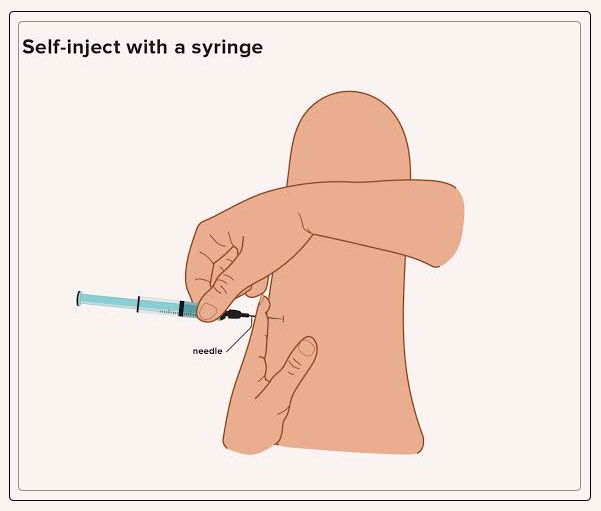
A sharp container is a red container that patients can purchase at any pharmacy.
It is used to collect medical waste like needles and syringes.
However, patients should not put any of these materials into the regular garbage, as needles can be hazardous to anyone who handles the trash.
Lastly, use a piece of gauze to apply light pressure to the injection site.
Patients can even massage the area to help the medication be absorbed in the muscle and it is normal to see slight bleeding.
They can use a bandage if necessary.
Learn more about Types of Wound Dressings here.
Tips for Easier Injection
To minimize possible discomfort, follow the tips below:
- apply ice or an over-the-counter topical numbing cream to the injection site before cleaning it with an alcohol pad at home during self-injecting
- allow the alcohol to dry completely before the injection, otherwise, it can cause stinging
- warm the vial of medication by rubbing it between the hands, prior to drawing the medication into the syringe
- in case of self-injecting, have someone give the injection as some patients may find it difficult to inject themselves.
Complications of Intramuscular Injection
It is typical to have some discomfort after an intramuscular injection.
However, certain symptoms can be a sign of a serious complication. Therefore, patients should call their doctor or healthcare professional right away if they experience:
- severe pain at the injection site
- tingling or numbness
- redness, swelling, r warmth at the injection site
- drainage at the injection site
- prolog bleeding
- signs of an allergic reaction like difficulty breathing or facial swelling
Moreover, patients may have some anxiety about performing or receiving an injection, especially an intramuscular injection due to the long needle.
They can read through the steps a number of times until they feel comfortable with the procedure.
Furthermore, they can ask their doctor or pharmacist to go through the procedure beforehand.
They are more than willing to help patients understand how to perform a safe, proper injection.
Conclusion
Intramuscular injections are a common and effective way to deliver medications and there are a number of possible locations to administer intramuscular injections.
In case patients need to self-administer an injection, they should ask their doctor for advice and guidance, and familiarize themselves with the process before they inject themselves, while alternatively, a trained family member or caregiver can also help.
However, it is important to seek medical advice or medical assistance if the person experiences prolonged or severe side effects after the injection.


